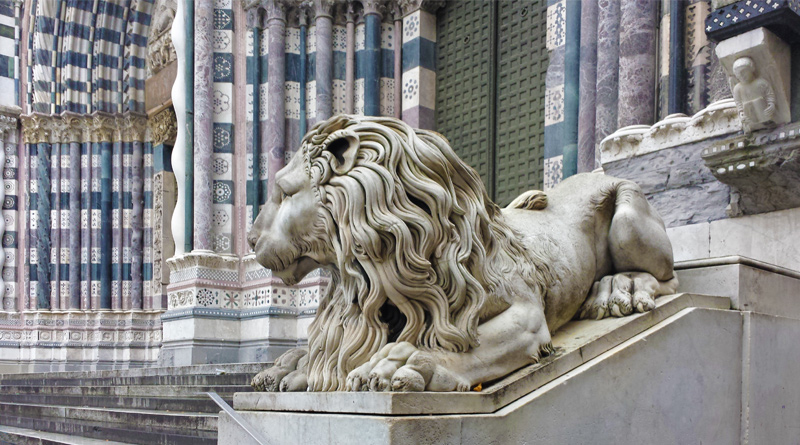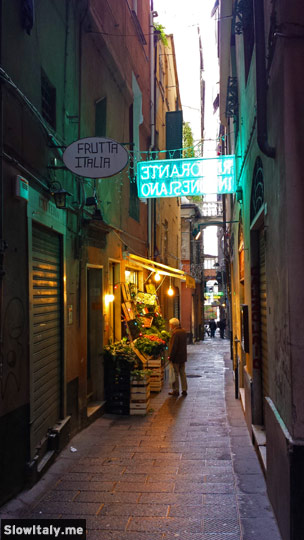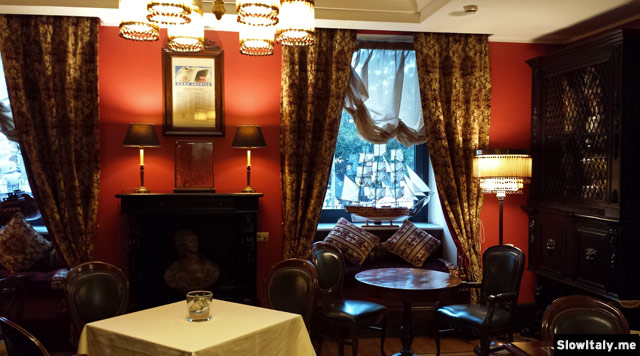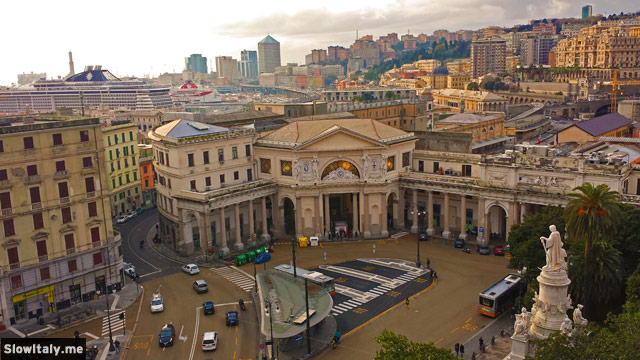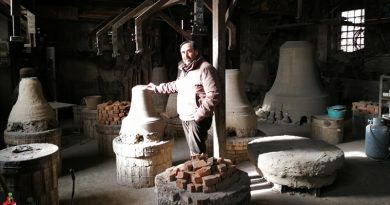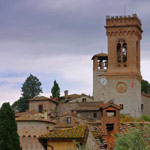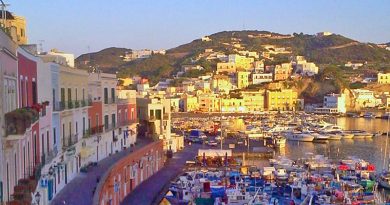10 reasons to visit Genoa next time you are in Italy
Genoa, like Turin, is one of these fascinating Italian cities that remain off the tourist radar: world famous as the birth place of Christopher Columbus, yet relatively unknown to the millions of tourists who visit Italy every year.
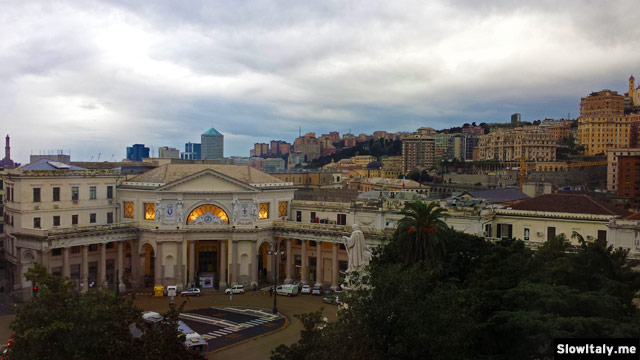
Dubbed La Superba by Petrarca, Genoa was one of Italy’s two largest maritime republics (together with Venice) that enjoyed enormous power and prestige as early as the Middle Ages. Multi-faceted and in perpetual mutation, the city ranges from the most luxurious aristocratic palaces in the Strade Nuove district – admired even by Rubens who wanted to apply some of the concepts to Antwerp -, to the Kasbah-like, narrow streets (caruggi) in the historic center.
The “Vertical Town” – forced to “climb up” the Sarzano hill as it extended from the sea -, is a surprising and startling city, where you enter in some buildings from the top floor, move around town using lifts, and where even the corridors inside the homes can be sloped and winding. There is also a unique church built above shops, an unusual elevator, the only one in the world that moves first horizontally then vertically and impressive fortified walls, the longest defensive city walls in Italy. Not to mention the pesto, focaccia, freshest fish and delicious confectionery. The whole city is just an amazing combination of strong colors and flavors, contrasts and curiosities, giving you at least 10 reasons to visit Genoa next time you are in Italy.
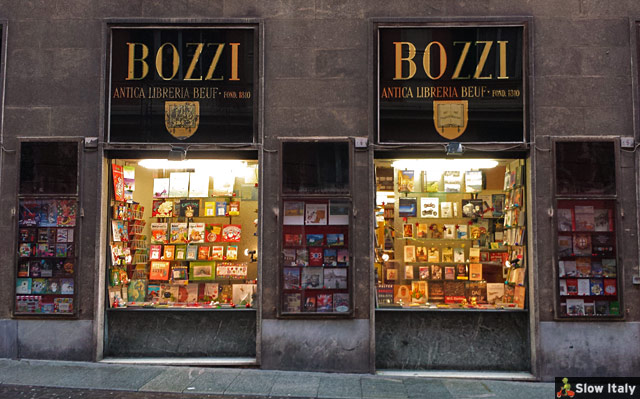
1. The Strade Nuove
The Strade Nuove (“New Streets”) were built by the most influential Genovese families to show off their prestige and power during the city’s “Golden Age” (1557 to 1627). The initiative resulted in a unique ensemble of magnificent late-Renaissance and Baroque buildings, one of Italy’s most sumptuous streets.
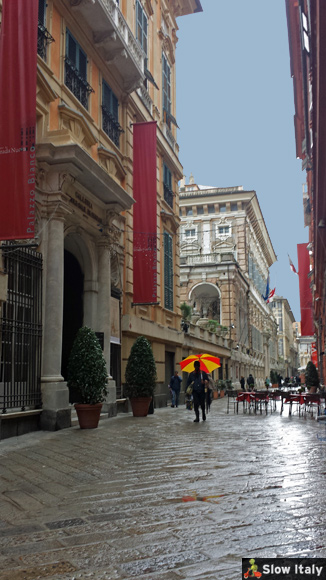
The Strade Nuove were one of the first examples of an urban development project in Europe that was carried out with a specific purpose, namely that of developing a system designed to offer accommodation to illustrious guests and noblemen on state visits in the city. The system was known as that of the Palazzi dei Rolli, after the lists or rolls on which these aristocratic residences, which had the privilege of hosting important visitors, were included. The residences were organized into three levels (bussoli) representing the luxury, size and beauty of the palaces and the importance and dignity of the guests.
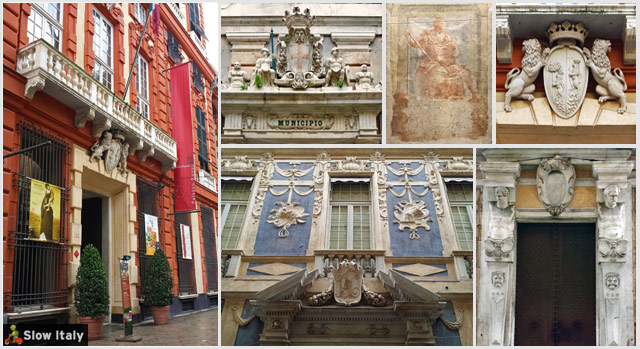
The site chosen was located in a more recent section (hence the name “Strade Nuove”), on the periphery of the civitas (city), in the so-called burgus, where the marine and agricultural activities of Genoa were originally located.
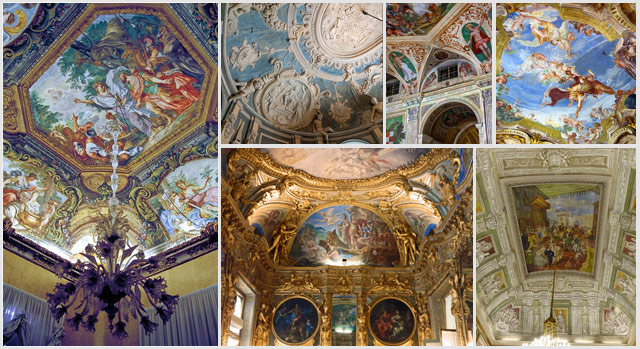
The main, most sumptuous street is Via Garibaldi (then known as Strada Nuova). Its magnificent palaces were all built between 1558 and 1584 (except Palazzo Rosso and Palazzo Bianco) with spectacular open staircases, courtyards and loggias overlooking gardens in a relatively tight space. The former Palazzo Tursi at number 9, now the townhall (municipio), includes the violin of Paganini and letters by Christopher Columbus, both native of Genoa.
However, the system of Rolli extended well beyond Via Garibaldi, including at least 120 palaces of which 42 have been added to the list of UNESCO World Heritage Sites in 2006.
The majority of the other palaces are located on Via Cairoli, previously Strada Nuovissima, (closeby is also the San Siro Church, the first cathedral of Genoa), Piazza della Meridiana, Piazza delle Fontane Marose, Salita Santa Caterina and Largo Eros Lanfranco, but a few are also to be found on Via Balbi, along Via Lomellini and Via San Luca. Don’t miss the characteristic Via del Campo, cited in a song by the Genovese Fabrizio De André, one of the most important Italian songwriters of all times.
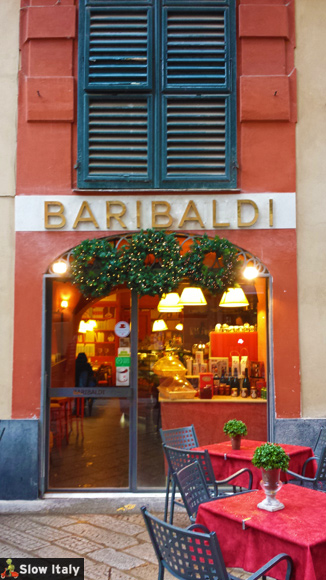
2. The Golden Gallery
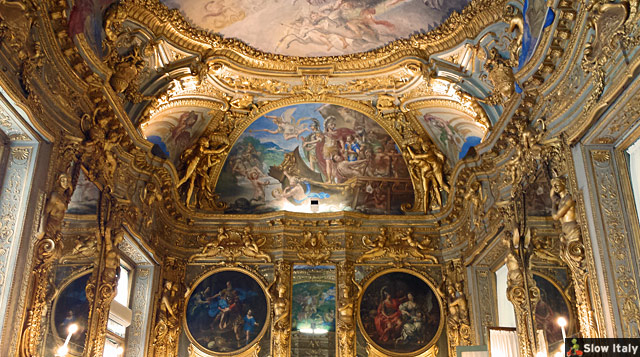
This is an insider tip! At number 4 in Via Garibaldi, you’ll find Palazzo Tobia Pallavicino-Carrega Cataldi, seat of the present Chamber of Commerce. The palace was built between 1558 and 1561 for Tobia Pallavicino, one of the wealthiest and most influential Genovese nobleman of that time.
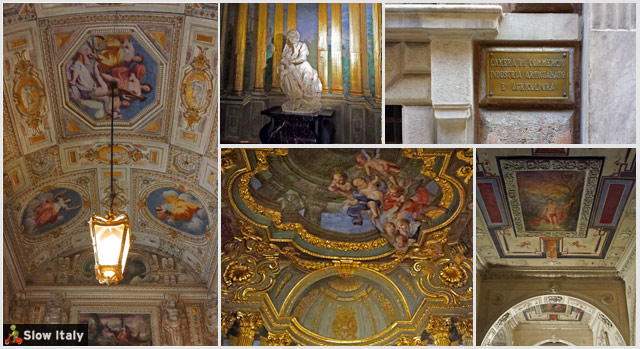
At the first floor of the Chamber of Commerce is a magnificent meeting room, known as the Galleria Dorata (Golden Gallery), all covered with frescoes and gilded decorations. Designed by Lorenzo de Ferrari (1680-1744), the room is not only his last and most important task, but also one of the most refined examples of Genovese rococo. Just enter the palace and kindly ask (best in the afternoon) if you can visit the “Galleria Dorata”.
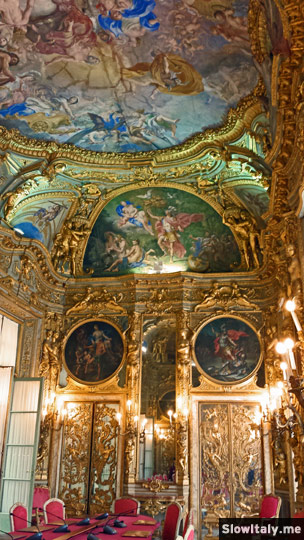
The owner after which the palazzo is named, Tobia Pallavicino, made his fortune by trading alum all over Europe. Alum was an essential mordant used to fixing dyes in the textile industry, a key sector in the Late Medieval and Early Modern Italian economy. Pallavicino practically held a monopoly on the precious ore, which was extracted in Tolfa, near Viterbo (province of Rome). Previously, alum had to be imported from the Middle East, from mines under Turkish control, through Venice, at excessive prices.
From 1541, Pallavicino and his brother controlled the importation of alum. His sons established themselves in Rome, London and Antwerp and further developed the family business. Needless to say that at the death of the patriarch his wealth was inestimable. The Galleria Dorata and other important renovations, however, date from the 1700s, when the palazzo was owned by the Carrega family.
3. The Centro Storico and the Mura (part I)
The historic center is a maze of narrow streets (caruggi), beautiful squares and ancient historic shops, worth exploring. While Genoa’s historic center is not the largest one of Italy – the ones of Naples and Rome are more extended -, it is definitely the one with the highest density of historic buildings (only ¼ of the buildings date from after WWII).
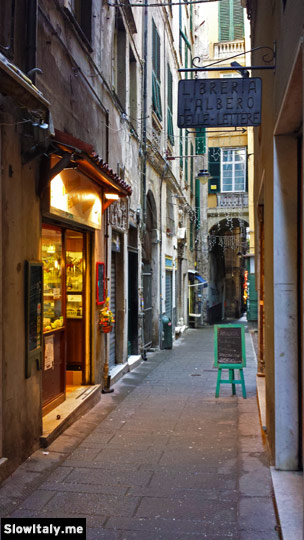
The caruggi is a typical Ligurian term that refers to the quaint, narrow and shady streets in the historic center of Genoa. The term probably derives from the word carriaggi, from the French charriage (goods transported by cart), maybe to designate the backstreets where goods were being transported and downloaded using carts. They can be indicated as “vico”, more rarely as “vicolo”, but sometimes also as “via” or even “piazza” (even if a very small one).

The most ancient part of the Centro Storico corresponds to the area located within the 9th century city walls (Mura), also known as the Carolingian walls (La cinta muraria Carolingia). The original walls had four gates and four towers, which were all destroyed. The area covered approximately 22 hectares and went from the ancient San Pietro gate (more or less where the San Pietro in Banchi Church is located), to Porta di Serravalle (off Piazza San Lorenzo) to the former Porta Soprana, and Porta del Castello (area of metro Sarzano and Via di Santa Croce).
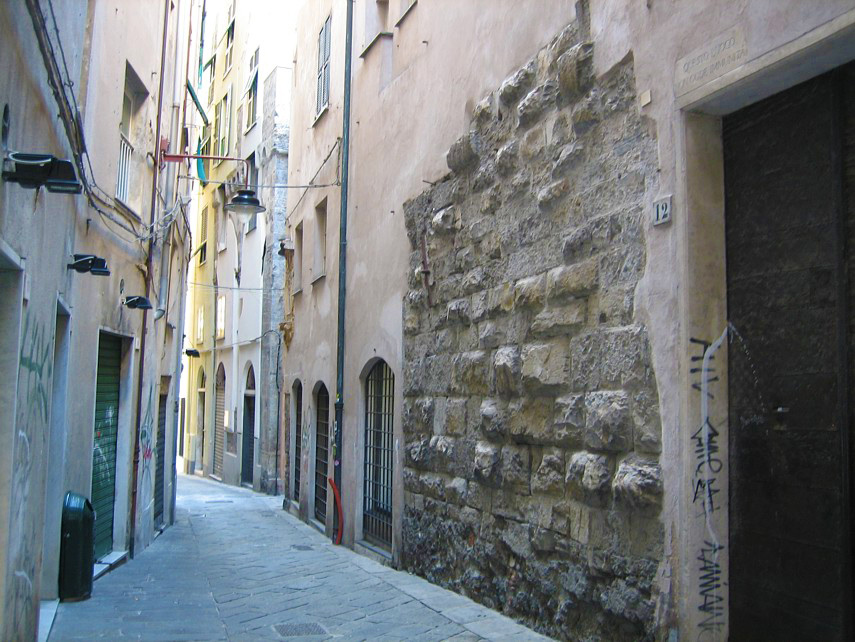
An even earlier fortified area dates back to Roman times and was situated within the oval formed by the convent of Santa Maria di Castello, the archeological area of San Silvestro (salita San Silvestro), Via di Santa Croce and Via di Mascherona.
In total, Genoa counts seven rings of walls that were built during subsequent periods, each corresponding to a different wave of expansion of the city. Actually, the city has more and longer walls than any other city in Italy. The last and most imposing walls, the Mura Nuove (New Walls), were built at the beginning of the 17th and are the longest defensive walls in Italy, and one of the longest in Europe. Today, only part of the original gates, forts and stretches of walls have survived.
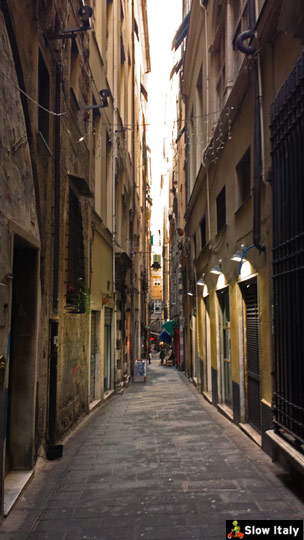
Very characteristic of the historic center is Via Cannetto Il Lungo. The street reminded me of some of the streets in the Tribunali district of Naples, which are dark even at midday as the buildings on each side of the street seem to bend towards each other at the top leaving only very little space for daylight to come through.
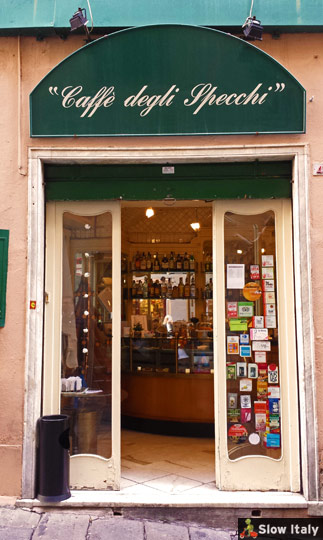
Worth seeing is also the Caffè delgi Specchi in Salita Pollaiuoli 43r and several artisan shops as well as Pescheria Risso, a characteristic fish stall with an impressive display of beautiful fresh fish in Via Canneto Il Lungo 48r.
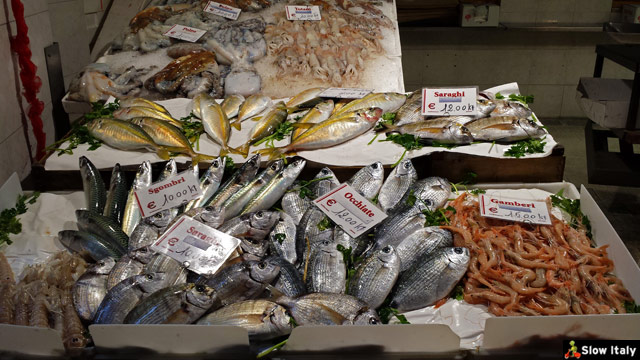
Fun trivia: as you may see the address above contains a “/r”, which stands for “rosso” (red). In Genova, street numbers are divided into black and red numbers, the black numbers being assigned to the main entrances of the buildings, while the red numbers were originally reserved for secondary entrances, usually leading to a (work)shop.
Proceed towards Piazza delle Erbe and Piazza San Matteo, a square with a definite medieval flavor, with its black-and-white striped houses, which belonged to the Doria Family, and Church of San Matteo. Andrea Doria was a great admiral (he consistently refused the position of doge) who gave Genoa its first aristocratic constitution which conferred it the status of mercantile republic and put an end to the factions which divided the city.
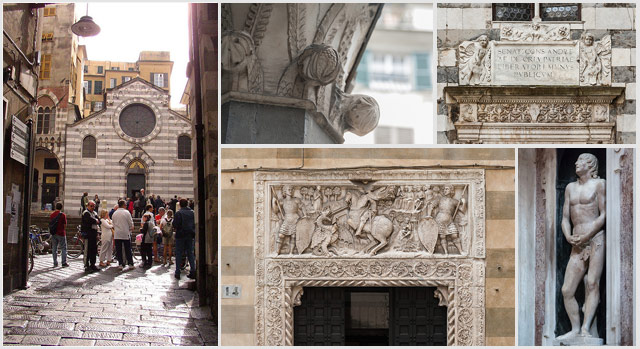
Within the most ancient part of the historic center lies also, of course, Piazza San Lorenzo with the Duomo (see further).
4. The Duomo and Piazza San Lorenzo
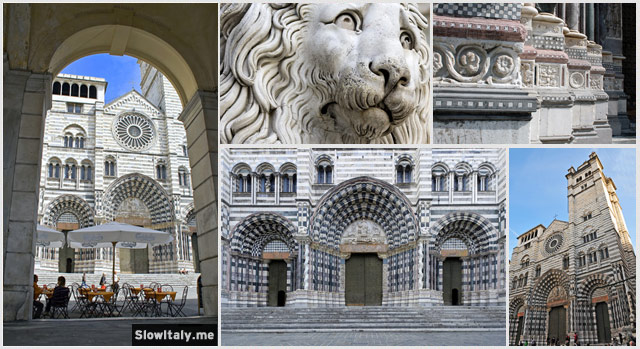
The magnificent, black and white striped Church of San Lorenzo became Genoa’s cathedral in 985. It was preferred over San Siro, the first cathedral of Genoa, which was located outside the Carolingian walls and therefore considered unsafe. Moving the cathedral was an important decision, which transferred the main center of the town to Piazza San Lorenzo. At that time, the original Piazza San Lorenzo was much smaller than today. The surrounding buildings were subsequently demolished in the 17th century to enlarge the piazza and make the cathedral seem even more impressive.
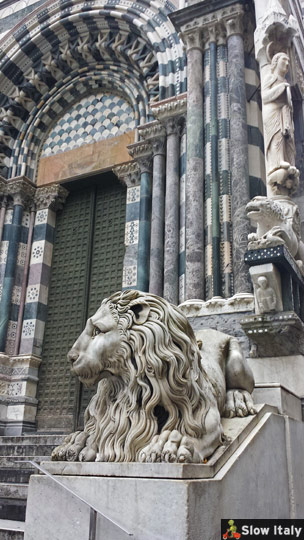
It took several centuries to complete the cathedral, even after it was consecrated in 1118. Important extensions and changes were made in the 13th and 14th centuries with the help of Pisan, Lombard and French artists. The black and white horizontal stripes date from the 13th century, while the two towers were added in the 15th century, resulting in a unique mixture of styles.
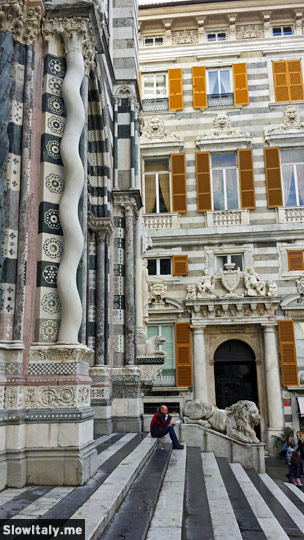
The largest of the side chapels is dedicated to St John the Baptist, patron saint of the city. It holds the relics of the Saint, which were brought to Genoa from the Holy Land during the Crusades in 1098.
Note the pharmacy at number 38 on Piazza San Lorenzo, which has been in operation since 1849, still with its original floor and furnishings. Opposite Via San Lorenzo is Via di Scurreria, named after the shield makers who used to have their workshops there. Most of the streets in the historic center bear names referring to the artisans who had their workshops here. Today the street is lined with fashion boutiques and jewelry shops.
When you walk parallel to the Duomo from Via di Scurreria to Via San Lorenzo crossing Piazza San Lorenzo, you clearly feel that the piazza is sloping, which together with the black & white stripes of the Cathedral, easily gives you a strange, unbalanced feeling!
On Via San Lorenzo at number 91r you’ll find the excellent Focacceria San Lorenzo. They have the most delicious Foccacia di Recco (with melted Stracchino cheese). The dough is very tasty and thin, leaving all the space for the delicious Stracchino to melt in the mouth. To die for!
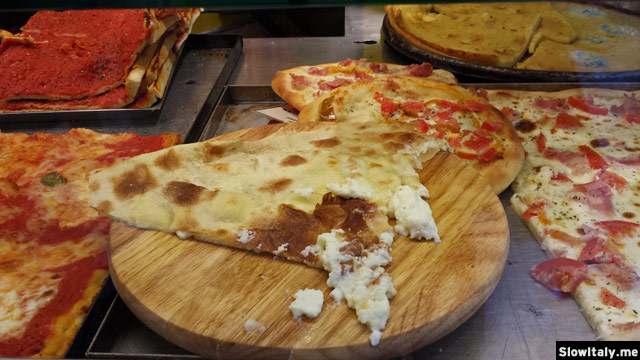
5. The Barbarossa walls and historic center (part II)
The next city walls, known as the Barbarossa walls, were erected between 1155 and 1163, to defend the city against Federico Barbarossa, German King, King of Italy and Holy Roman Emperor. It contained a greatly expanded area as compared to the previous walls: 55 hectares instead of the original 22. The walls had three main gates with high semicircular towers, two of which survived to these days, Porta Soprana (the main entrance to the city) and Porta dei Vacca.
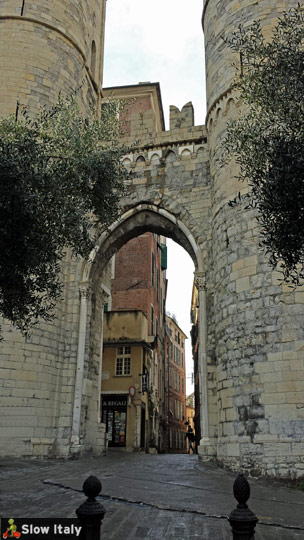
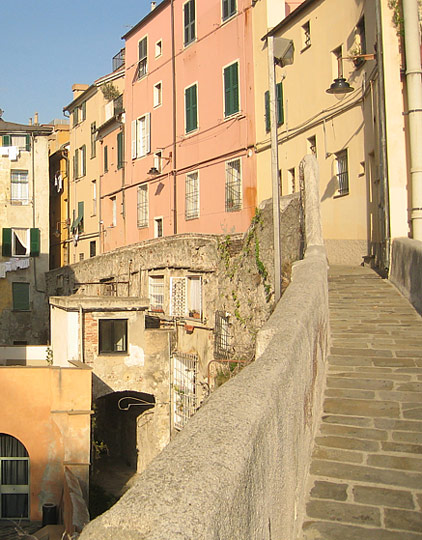
Worth seeing within this part of the historic center is Piazza Banchi, one of the most picturesque squares of the city, with its unique Chiesa di San Pietro built above a series of shops, which financed the construction of the church. Piazza Banchi was once one of the city’s busiest market places, where moneylenders would set up their stands, hence the name.
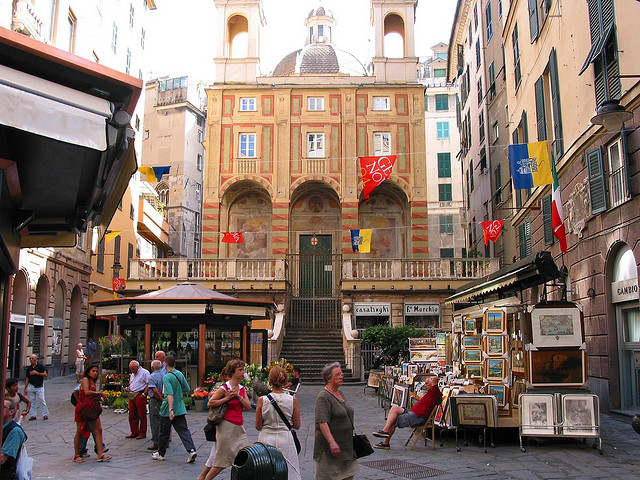
Stroll along Via Luccoli and Via Macelli Di Soziglia, two picturesque streets of the historic center.
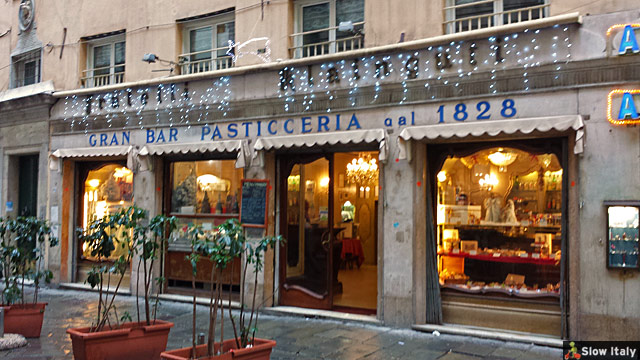 The two streets meet in Piazza Campetto e Soziglia, where two of Genova’s most ancient historic confectionery shops are located: Romanengo and Caffè di Klainguti, where you can completely indulge yourself!
The two streets meet in Piazza Campetto e Soziglia, where two of Genova’s most ancient historic confectionery shops are located: Romanengo and Caffè di Klainguti, where you can completely indulge yourself!
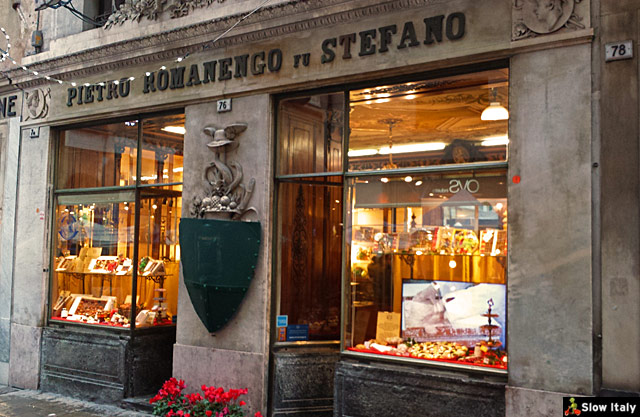 The maze of caruggi in the Maddalena quarter and surroundings is full of delightful little shops and ancient botteghe.
The maze of caruggi in the Maddalena quarter and surroundings is full of delightful little shops and ancient botteghe.
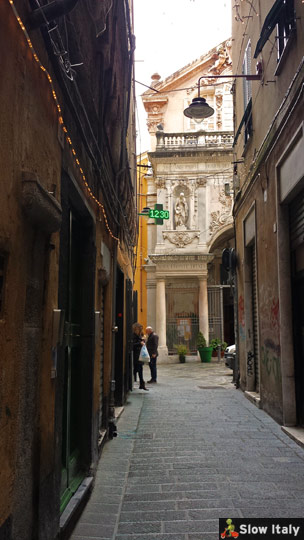
6. Christopher Columbus’ house

The tiny Casa di Cristoforo Colombo, located at the foot of Porta Soprana, is (supposedly) where the famous explorer Christopher Columbus spent his childhood. He lived here from the age of 4 to 19, when his father was the guardian of the Porta Soprana between 1455 and 1470. The house was rebuilt many times, the current version dating back to the 18th century, but the lay-out and and size have kept close to how it probably looked like at that time.
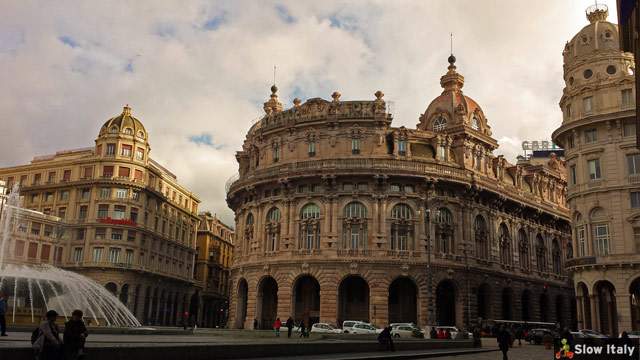
On your way to Christopher Columbus’ house, don’t miss Piazza de Ferrari with the Palazzo della Borsa (1907-1912), the Teatro Carlo Felice, the Accademia Ligustica di Belle Arti, the Palazzo of Regione Liguria and the Palazzo della Borsa.
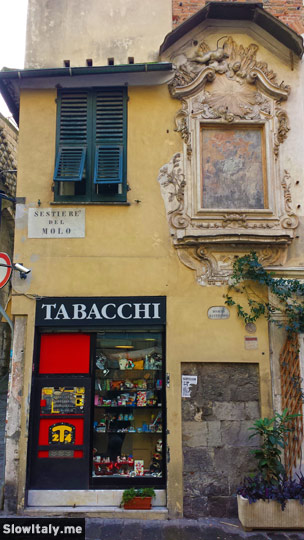
From Columbus’ house, proceed towards Porta Soprana and the charming little square Piano di Sant’Andrea, inside the walls. From there take one of the caruggi towards Piazza delle Erbe.
7. Trekking in the city and Spianata Castelletto
The Spianata Castelletto offers one of the most scenic views over the city. Either take the public lift from Piazza Portello to the Belvedere Luigi Montaldo, or, for the most courageous among you, you may also choose to walk up the hill (about 30 min).
Interesting is also the view from the Museo delle Culture del Mondo housed in Castello d’Albertis. The museum itself contains a large, interesting collection of historical artefacts from all over the world stemming from the various trips done by Enrico d’Albertis. Even more impressive than the museum is the way to reach it! The castle can be reached from the center (top of Via Balbi) by the lift Montegalletto, the only lift in the world that moves first horizontally and then vertically!
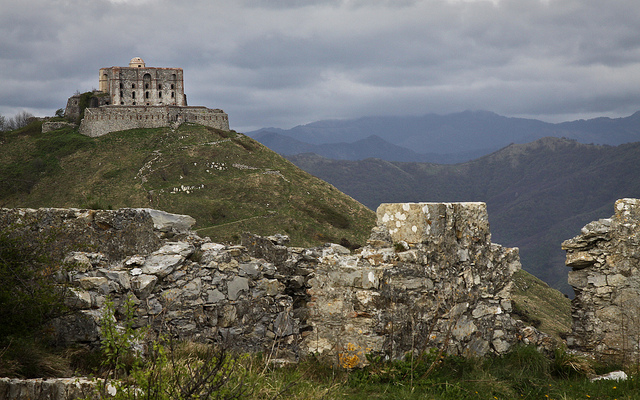
Beautiful to trek through is also the Parco delle Mura, which can be explored on foot or by bike within a wonderful natural reserve. Various trails connect the forts that were part of the 14th century and the New Walls. The latter were built along the ridge of the hills around the city and stretch from the Forte Tenaglia, Forte Sperone and Forte Diamante in the west to Forte di San Martino and Forte San Giuliano in the east, just to name a few.
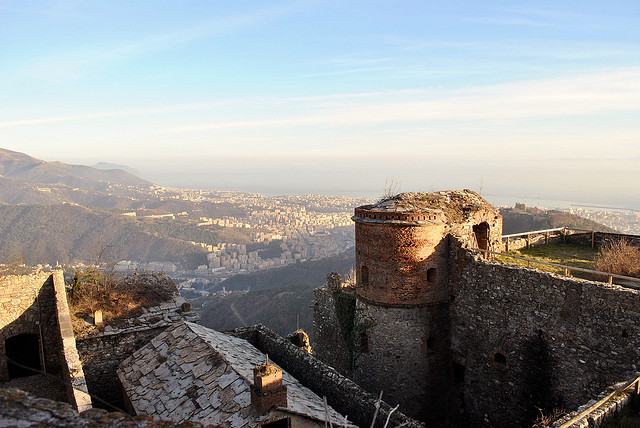
Another way to hike the city is following the crêuze (or creuse), a network of tiny, steep, cobblestoned pedestrian paths that connect the city center with the bucolic hinterland. The creuse network is unique in its kind in Europe, providing an alternative way to reach the hill quarters of the city. They offer a peaceful relief from the busy center by bringing slow moments immersed in the bucolic country life almost in the city center. The typically Ligurian term became famous with the album by Fabrizio di André, called Crêuza de mä, sung entirely in Ligurian language.
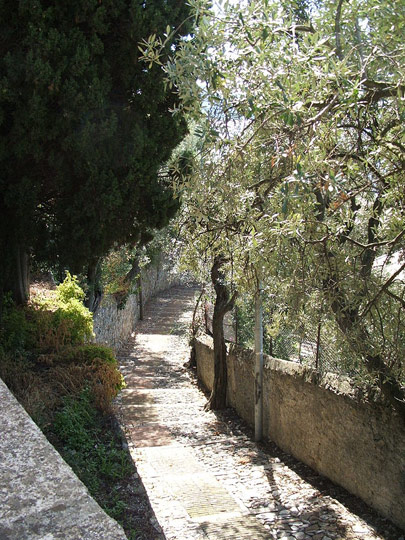
8. The Porto Vecchio, Lanterna and Aquarium
The Porto Vecchio is the curve that stretches from the Molo Vecchio (Old Wharf) to the Lanterna, the 76m hight lighthouse and emblem of Genoa. The area of the Porto Vecchio was renovated by the famous architect Renzo Piano at the occasion of the international expo commemorating the 500th anniversary of the discovery of America, creating a single pedestrian zone that goes from Piazza Caricamento into the port. Renzo also built the Bigo and Sfera. The Bigo looks like a large, white crane. It contains a panoramic lift that rotates at 360° offering an amazing aerial view of the city and its amazing maze of caruggi (narrow streets).
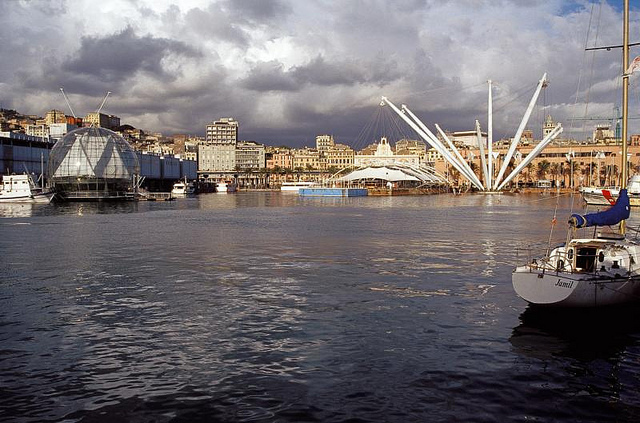
The Sfera, designed like a “drop” of steel and glass suspended over the sea, recreating a miniature rain forest, includes a small, but rich, botanical and animal garden hosting plant and animal species coming from tropical forests threatened by human exploitation. Birds, amphibians, butterflies and reptiles circulate freely.
Genoa’s lighthouse and emblem, the Lanterna, is visible to all those who put in at the port, from whatever direction. It was last rebuilt in 1543. Walk up the 375 steps to admire the beautiful panoramic view from its terrace.
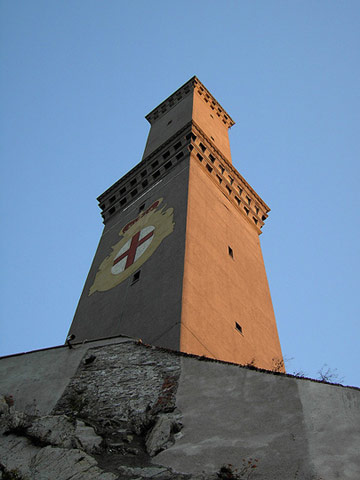
Also located in the Porto Antico is the Genoa Aquarium (Acquario di Genova). Opened in 1992, it is Europe’s largest marine attraction hosting 800 different species and more than 10,000 marine creatures. At the moment of its opening it was the second largest aquarium in the world. A complete visit takes about 2 hours 30.
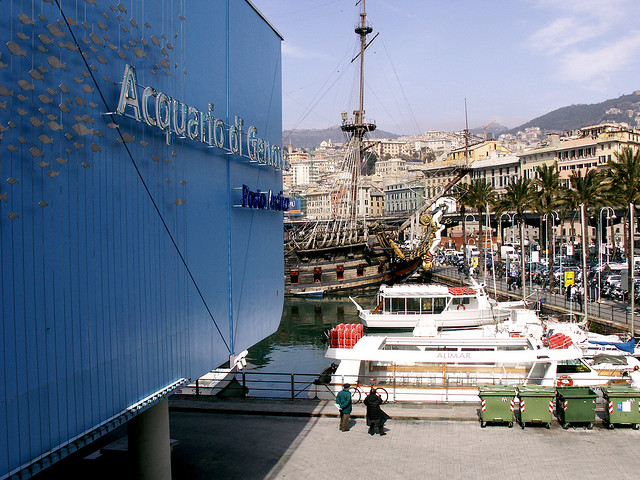
9. Boccadasse
For beautiful scenic photos, head to the picturesque old fishing district of Genoa. With its colorful houses, pebble beach and colorful boats, Boccadasse, offers a beautiful backdrop for your photos. You can reach the narrow bay of Boccadasse following Corso Italia from the center.
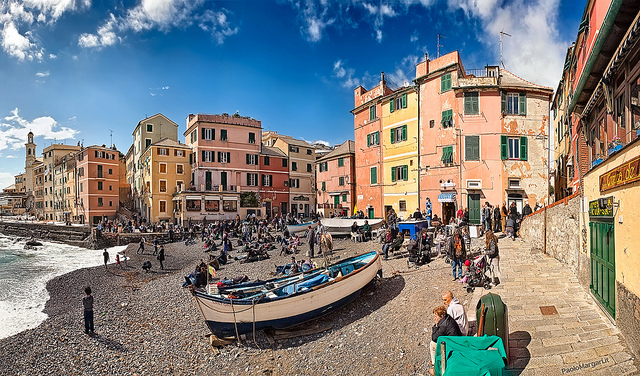
Note that La Boca, a district in Buenos Aires, was founded by Genovese immigrants from Boccadasse.
10. Museo Diocesano and the oldest jeans in the world
To close our visit of Genoa, I’d like to end with an interesting etymological trivia about the city. You may not know this, but it was from the city’s name that the common word “jeans”, used in almost every language of the world, is derived.
Indeed, Genoa was once renowned for manufacturing work clothes that were tinted with indigo blue. At that time it was customary to name fabrics after the city from which they originated. The jeans fabric from Genoa was stamped as Gênes (the French name for Genoa), which, when the fabric arrived in England, where it was processed, was pronounced with the English accent, which gave a word sounding like “jeans”.
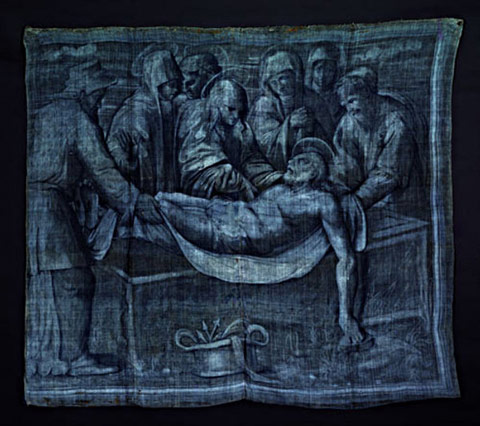
The oldest denim in the world, originating from Genoa, can be seen in the Museo Diocesano (close to the Duomo). The jeans cloth was used as a canvas in 1538 to represent a painting of the Passion of Christ.
Where to stay
We stayed at Grand Hotel Savoia, ideally located within walking distance of the Strade Nuove, the historic center and Porto Vecchio. Ask for a room with city view over the beautiful Piazza Principe (see photo at the beginning of the article). From its rooftop terrace, the hotel offers a beautiful panorama over the entire city. Other pluspoints are the beautiful breakfast buffet, comfortable rooms and very friendly staff.
Grand Hotel Savoia
Via Arsenale di Terra, 5
16126 Genova
010/27721
Where to eat
Even though Genoa has a wide range of typical trattorie and restaurants, I’d like to mention this wonderful fish restaurant a little outside Genoa (about 15min by car from the center). The place is a bit off-the-beaten track, not frequented by tourists, but offers an incredible choice of the finest and most delicate fresh fish, in a friendly, unpretending atmosphere.
Trattoria Barisone
Via Siracusa 2/r
16154 Genoa – Sestri Ponente
010/6049863
For starters we had an amazing choice of anchovies, prepared in five different ways, novelli (baby octopus) and bianchetti (minute whitebait of anchovies, prepared in five different ways, a delicacy!). Actually, we decided to stick to the starters, as the variety and quantity of dishes were really gargantuesque!
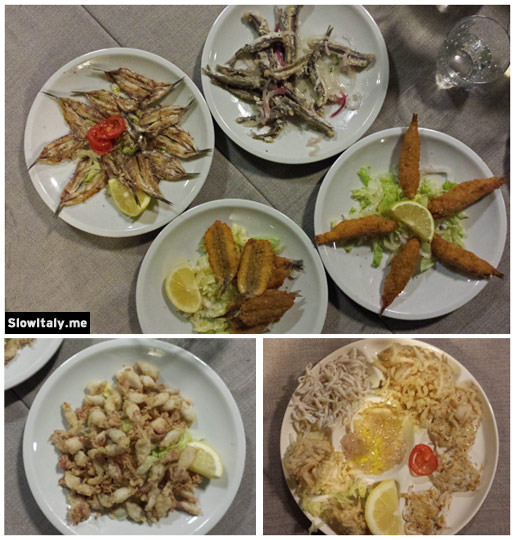
Photo credits: all photos and photo collages © Slow Italy, except (from top to bottom): ancient wall in via Tommaso Reggio by F. noceti; Walkway Barbarossa by Nellorolleri; Piazza Banchi by cercamon; Forte Diamante by Tommy; Forte Sperone by Walter Dellepiane; Porto Vecchio by Jacqueline Poggi; Lanterna by Silvia Molinari; Acquario by Paul; Boccadasse by Paolo Margari.
Collage Via Garibaldi Palces indoors (from the left clockwise): Palazzo Pantaleone Spinola by Jacqueline Poggi; Palazzo Lomellino by Jacqueline Poggi; Palazzo di Angelo Giovanni Spinola by Jaqueline Poggi; at nr 5; Palazzo Rosso fresco by Gregorio de Ferrari by Sailko;; Palazzo Tursi by Postcrosser; Palazzo Tobia Pallavicino by Slow Italy. Collage San Matteo (from the left, clockwise): Piazza San Matteo by Riccardo; 2 photos by Jacqueline Poggi. Collage San Lorenzo Cathedral (from the left, clockwise): © oreundici/Fotolia.com; © lappa85/Fotolia.com; © paolacarobbi/Fotolia.com; © lamio/Fotolia.com and © victormendini/Fotolia.com.

